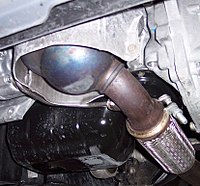
Photo from wikipedia
The reaction of HCHO with Beijing winter's real ambient particulate matter (PM) inside a 3.3m3 Teflon Chamber was conducted in this study. NO2, O3 and H2O gases were removed from… Click to show full abstract
The reaction of HCHO with Beijing winter's real ambient particulate matter (PM) inside a 3.3m3 Teflon Chamber was conducted in this study. NO2, O3 and H2O gases were removed from the ambient aerosol before entering into the chamber. The decays of HCHO were monitored (acetylacetone spectrophotometry method) during the reactions at different PM number concentrations (Na) and relative humidities (RHs), and the formed particulate formate was detected by IC and XPS techniques. The results showed that when RH was 10%-15%, the decay rate of HCHO in the chamber was higher with the existence of PM from relatively clean days (with number concentration (Na)<200,000particle/L, 0.35-22.5μm) compared to dirty days (Na>200,000particle/L, 0.35-22.5μm). When RH increased to 30%-45%, PM can hardly have significant influences on the decay of HCHO. The formations of formate on the reacted PM were consistent with the HCHO decay rates at different ambient PM Na and RH conditions. This is a first study related to the "real" ambient PM reacted with HCHO and suggested that in the clean and low RH days, PM could be an effective medium for the conversion of HCHO to formate.
Journal Title: Journal of environmental sciences
Year Published: 2017
Link to full text (if available)
Share on Social Media: Sign Up to like & get
recommendations!